The little mini mandarins have overtaken the market! There are so many different brands being marketed at this time, all with what seems to be similar packaging, but die hard fans now that Cuties Citrus provides consistent quality fruit that is worth returning for! I was lucky enough to get a tour of the mandarin harvesting and packing process at Cuties Citrus and am very excited to get to share it with you.
Table of Contents
What Type of Citrus is a Cutie?
The Cuties brand consists of both Clementine mandarins and the W. Murcott mandarins. They are both advertised as Cuties and are sold interchangeably.
When are Cuties in Season?
Cuties are sold and available year-round. There is an approximate six month Cuties harvesting and packing window between November and April when Cuties are available in California. The Clementine mandarins are available during the first half of the season and the W. Murcott mandarins are available during the second half of the season.
Since the time of my visit in 2016, this window has since become year-round, as Sun Pacific imports Cuties grown in other countries. As a consumer, I have seen Cuties coming from South America, as well as South Africa (incredible!).
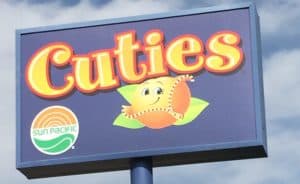
How are Mandarins Harvested?
Mandarins are harvested using clippers. During the Cuties harvest, they use special clippers that attach to the inside portion of the harvesters’ hand. The mandarins are placed into harvesting bags worn by the harvesters and then are gently dropped into plastic bins. They position the bins throughout specific rows in the orchard, so that the harvesters have a centralized point to return to as they progress through the orchard. Once the bins are full (with up to 4,800 mandarins per bin), they are stacked and are transported to the packinghouse.
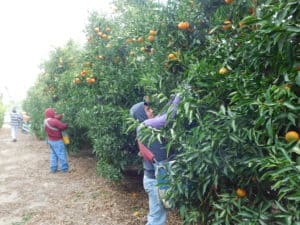
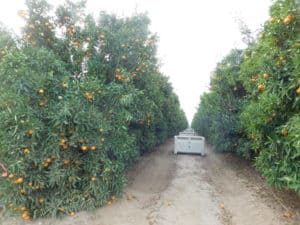
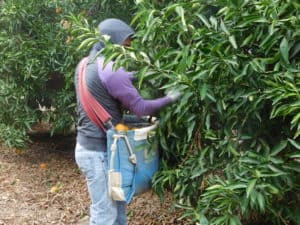
What determines when mandarins are ready for harvest?
Mandarins are not harvested until the fruit has reached a specific sugar:acid ratio.
Do mandarins continue ripening after harvest?
No, mandarins are non-climacteric fruit and will not continue ripening after harvest.
For the mandarins harvested for the U.S. market, they are harvested as orders are received, so the fruit has more time to ripen properly on the tree.
Citrus Degreening
If the mandarin rinds still contain green upon arrival to the packinghouse, they are put into a degreening room where they receive an ethylene application. Since mandarins are non-climacteric and do not continue ripening after harvest, the ethylene will not alter the ripeness of the fruit, but will help convert the green rind color to orange (along with other potential side effects, such as faster aging). The picture below is an example of what a citrus degreening room.
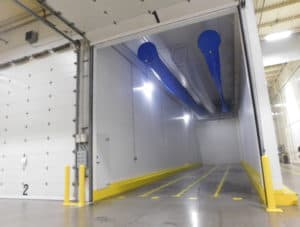
How are Mandarins Packed?
The packing process for mandarins is similar to what you will find at other citrus packinghouses.
- Bin Dump – The bins arrive from the field and are dumped onto the packing line, with an initial rinse to sort out leaves and other field debris.
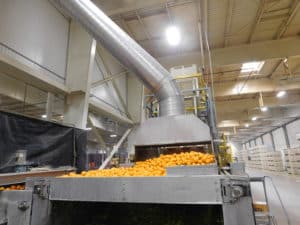
- Black Light Room – The mandarins pass through a black light room, where there is a UV light that detects mold on the fruit for the hand sorters to remove.
- Wash Step – The mandarins pass through a single-pass wash step with sanitizer and then through a dryer.
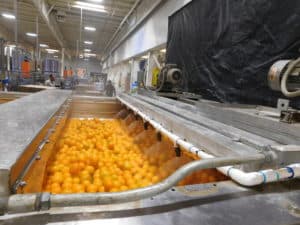
- Wax Step – The fruit is sprayed overhead with a wax (containing fungicide) and go through a second drying step. This step is performed for appearance purposes, as well as to help prevent against pathogen growth (e.g., blue/green mold).
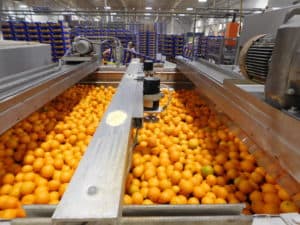
- Hand Sort – The mandarins are hand sorted to remove any fruit with defects, mold or green color.
- Black Light Room – The fruit passes through a second black light room to ensure that all moldy fruit is disposed of prior to packing. There are two different black light rooms set up, so that the second room catches anything missed by the first room and the hand sorters. That is how big of a problem mold can be to a citrus crop.
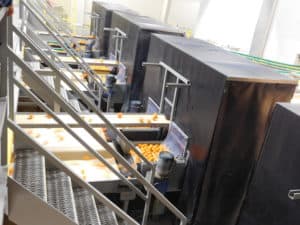
- Machine Sort – The mandarins are mechanically sized, sorted by color, labeled, and transported to the appropriate packing line.
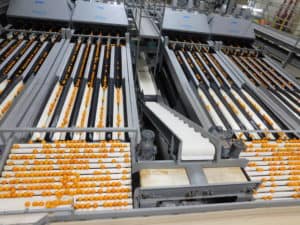

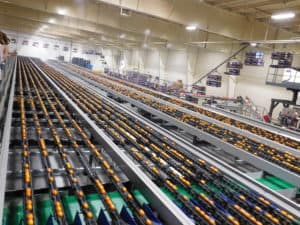
- Hand Sort – There is one final hand sorting step prior to packing.
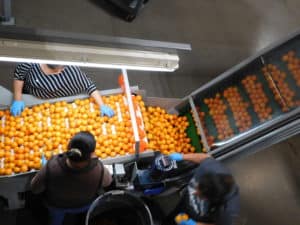
- Machine Pack – The mandarins are transported to a machine that packs the red bags with the blue Cuties label that you are probably used to seeing in the grocery store. The bags are then transported on a conveyor line to be hand packed into boxes and palletized.
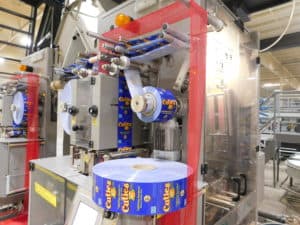
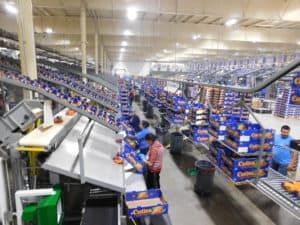

- Palletize – The pallets are shrink-wrapped, taken to cold storage and prepared for transport.
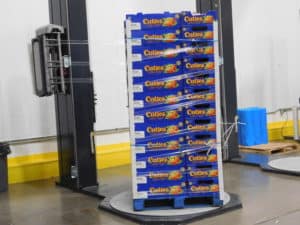
In the video below, you can follow all of the steps that a Cutie takes prior to making it to the grocery store.
How Citrus Producers Battle Mold on Oranges & Other Citrus
The main problem that citrus producers face is mold, specifically Green mold (Penicillium digitatum) and Blue mold (Penicillium italicum). This can become a major issue, as once one piece of citrus in a bin becomes contaminated, it spreads quickly. In order to combat this, it is common practice to have a “black light room,” where UV lights detect decay during the initial steps on the packing line, and workers are able to cull the decayed fruit. This was also the case at the Cuties packinghouse, where there were two separate black light rooms.

Food Safety Considerations
For a mandarin harvesting and packing operation, some of the main food safety concerns are:
- Sanitation of the harvesting tools – Tools should be cleaned and sanitized, including having a clean place to store them while the workers are on break, and the company needs to have a program in place to store the knives overnight instead of having the workers take them home with them.
- Sanitation of the harvesting bags and bins – Cleaning and sanitizing of the bags and bins needs to occur on a regular and frequent basis. In this case, they are using bags that need to be laundered (differently from how you would clean a bin or harvesting bucket).
- Testing and changing of the wash water – The mandarins are exposed to water during the wash step when they are first dumped onto the packing line. The water needs to be frequently tested and monitored, based on the policy in place.
- Worker hygiene – Since the harvesters touch every mandarin they harvest and the workers at the packing house hand sort them, there is a lot of handling taking place. Whether they are using their bare hands or gloves, there needs to be a hygiene policy in place to ensure that hand washing occurs every time before they return to work, and if they are using gloves, that they are clean and/or switched out regularly.
There are many more items to be taken into consideration, but this is just a brief list to get you thinking about it!
Frequently Asked Questions
What is the growing season for Cuties that are grown in California?
November to April. Cuties that are grown in California are the only Cuties that are grown in the United States. The rest are imported throughout the year to fill in the gaps, which you may have seen marketed as Summer Cuties.
Are Cuties seedless?
Yes, they are seedless!
Are Cuties GMO?
No, Cuties have not been genetically modified. I get a lot of questions wondering how they can be seedless and not genetically modified and that is due to traditional breeding practices.
How do you peel an orange without hurting your finger nail?
Use a knife to make the initial indentation into the citrus, or use your teeth. Then, you peel the rest as normal and don’t have the issue with hurting your finger nail with the initial indentation!
Featured Grower Information
I would like to thank Cuties Citrus (Sun Pacific) for allowing me to visit and to share the Cuties harvesting and packing content. In addition to mandarins, Sun Pacific also grows and distributes Mighties kiwifruit.
If you enjoyed this post, you might also like:

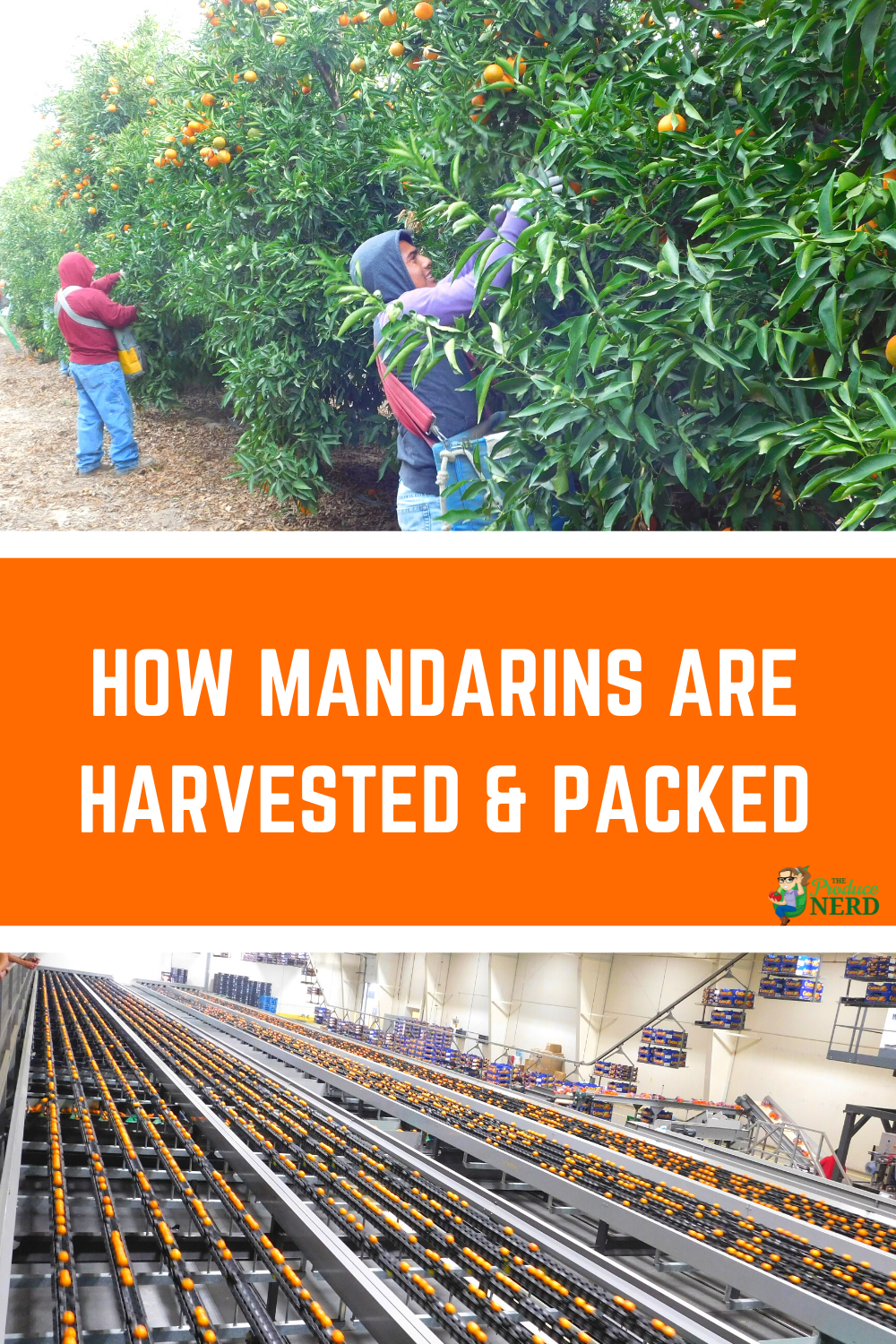
I was wondering if you offer any tours of your facility, been a long time fan of Cutties and always drive by it on the 99. Was curious if you offer tours for families to learn about production/quality control/ taste testing etc.